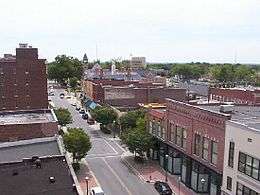Rock Hill, South Carolina
| Rock Hill, South Carolina | ||
|---|---|---|
| City | ||
| City of Rock Hill | ||
|
Downtown Rock Hill | ||
| ||
| Nickname(s): The Gateway to South Carolina; Football City USA | ||
| Motto: Always On. | ||
|
Location of Rock Hill in South Carolina | ||
| Coordinates: 34°56′17″N 81°1′34″W / 34.93806°N 81.02611°WCoordinates: 34°56′17″N 81°1′34″W / 34.93806°N 81.02611°W | ||
| Country | United States | |
| State | South Carolina | |
| County | York | |
| Founded | 1852 | |
| Incorporated | 1892 | |
| Government | ||
| • Type | Judicial | |
| • Mayor | Doug Echols (D) | |
| Area | ||
| • Total | 43.16 sq mi (111.8 km2) | |
| • Land | 43.16 sq mi (111.8 km2) | |
| • Water | 0.16 sq mi (0.4 km2) 0.4% | |
| Elevation | 676 ft (206 m) | |
| Population (2016)[1] | ||
| • Total | 72,937 | |
| • Density | 1,532.8/sq mi (591.8/km2) | |
| Time zone | Eastern (UTC-5) | |
| • Summer (DST) | Eastern (UTC-4) | |
| ZIP codes | 29730-29733 | |
| Area code(s) | 803 | |
| FIPS code | 45-61405[2] | |
| GNIS feature ID | 1250417[3] | |
| Website |
www | |
| Wikivoyage has a travel guide for Rock Hill. |
Rock Hill is the largest city in York County, South Carolina and the fifth-largest city in the state.[4] It is also the fourth-largest city of the Charlotte metropolitan area, behind Charlotte, Concord, and Gastonia (all located in North Carolina, unlike Rock Hill). As of the 2010 Census, the population was 66,154. In 2016, the population had increased to 72,937.[5]
Rock Hill is located approximately 25 miles (40 km) south of Charlotte and approximately 70 miles (110 km) north of Columbia.
Rock Hill offers scenic riverfront views along the Catawba River and is home to numerous nature trails, restaurants, and thirty-one parks which are used for both national and local events. It's historic downtown consist of twelve contiguous buildings built as early as 1840 offering dining and retail options.
History
_1933.jpg)
Pre-colonization
Succeeding cultures of indigenous peoples lived in the Piedmont for thousands of years. The historic Catawba Indian Nation, a traditionally Siouan-speaking tribe, was here at the time of European encounter. Currently the only tribe in South Carolina that is federally recognized, its members live near Rock Hill.
Early colonization
Although some European settlers had already arrived in the Rock Hill area in the 1830s and 1840s, Rock Hill did not become an actual town until the Charlotte and South Carolina Railroad Company made the decision to send a rail line through the area. Originally, the railroad had hoped to build a station in the nearby village of Ebenezerville which was squarely between Charlotte, North Carolina and Columbia, South Carolina. When approached, however, the locals in Ebenezerville refused to have the railroad run through their village since they considered it dirty and noisy. Instead, engineers and surveyors decided to run the line two miles away by a local landmark. According to some accounts, the engineers marked the spot on the map and named it "rocky hill."[6](p26)
Some of Rock Hill's early founding families—the White family, the Black family, and the Moores—believed that having a rail depot so close to them would be advantageous, so they decided to give the Columbia and Charlotte Railroad the right of way through their properties. As the three largest landowners in the area, this settled the matter. George Pendleton White contracted with the railroad to build a section of the line. Construction began in 1848. The first passenger train arrived on March 23, 1852. A few weeks later, on April 17, 1852, the first Rock Hill Post Office opened.[6](pp26–28)
Now that Rock Hill had a name, a railroad station, and a post office, it began to draw more settlers to the area. Captain J. H. McGinnis built a small general store near the station in 1849 or 1850 to provide supplies for the construction and railroad workers.[6](pp27–28) Templeton Black, who had leased the land to McGinnis, decided to devote some of his other adjacent land to building a larger town. He hired a local surveyor, Squire John Roddey, to organize a main street. Black sold his first plot of land along that street to Ira Ferguson for $125 a few weeks before the post office opened; other businessmen bought plots quickly after that.[6](p28)
Rock Hill Academy, the first school in Rock Hill, opened in September 1854. Despite its official name, most residents referred to it as the Pine Grove Academy after the pine grove it was located in. Ann Hutchinson White, wife of George White, donated the land to the school after her husband's death. The school had 60 male pupils in 1856; a school for girls was later opened in the same place.[6](p28)
Other significant facts and dates
- Pre-December 1857: The Indian Land Chronicle, Rock Hill's first newspaper, begins publishing. After a change in ownership, it was renamed The Rock Hill Chronicle in 1860.[6](p33)
- Pre-1860: Rock Hill had at least two doctors: Robert Hervey Hope and William Barron Fewell[6](p33)
During the American Civil War
Shortly before the American Civil War began a census had been taken of the population in York County, where Rock Hill is located. Half of the district's 21,800 residents were slaves, integral to local cotton production. The 4,379 white males in the county formed fourteen infantry companies; some of the men joined cavalry or artillery units instead. By the end of the war, 805 of these men were dead, and hundreds more were wounded. Men from Rock Hill and York County were involved in many of the major Civil War battles.[6](p35)
Due to its position on the railroad, Rock Hill became a transfer point for Confederate soldiers and supplies moving to and from the front. Since there was no local hospital, townspeople nursed sick and wounded soldiers in their homes. Refugees fleeing the coastal blockade or General Sherman's troops also came to Rock Hill.[6](p39)
Beginning in the spring of 1862, local area farmers switched from cotton to corn in order to produce more food.[6](p39) Records show that prices in Rock Hill changed frequently during the war, reflecting both shortages and the inflation of the Confederate paper money.[6](p41)
Confederate General P. G. T. Beauregard set up a temporary headquarters in Rock Hill on February 21, 1865.[6](p41) He ordered the roads to Charlotte blocked to try to prevent General Sherman from reaching the city; Sherman ultimately went in a different direction.
When General Lee surrendered at the Appomattox Court House, it was actually a future Rock Hill resident who was responsible for waving the white flag. Captain Robert Moorman Sims, a farmer from Lancaster County, was sent by General James Longstreet to inform Union troops that the Confederate troops wanted a truce.[6](p42)
Post-Civil War
The Civil War changed the social, economic, and political situation in Rock Hill tremendously, as it did elsewhere in the South. Rock Hill grew as a town, taking in war refugees, widows and their families, and the return of the men who had left to fight the war.[6](p58) The formerly wealthy elite sold off their land to stay afloat financially. Town life began to become more important than rural life.
Most of the merchants in Rock Hill around 1870 were former Confederate soldiers; many were entrepreneurs who were new to town, trying to start over.[6](p59) In 1870, even the largest stores in Rock Hill were only one story tall, and there were no sidewalks on the roads. The first drug store in Rock Hill opened in the 1870s.[6](p61) A locally contentious bordello was built in 1881 and introduced the town's first paved sidewalk.[6](p61)
Incorporation
The town was not officially incorporated until 1870, on the third try.
The first attempt to get Rock Hill incorporated was made in 1855. A petition, signed by major landholders and businessmen from the Rock Hill area, was presented to the General Assembly on October 19, 1855.[6](p29) No action on the matter was taken by the General Assembly.
The second attempt was in 1868. In their petition, the townspeople claimed that Rock Hill had over 300 residents, "eleven stores, two churches, two bars, two hotels, two carriage shops, three blacksmith shops, three shoe shops, one tannery, one cabinet shop, and elementary schools for white girls and boys." The petition was signed by 48 men, most relative newcomers to Rock Hill, with only a few members of the old, established, landed families. The larger landholders opposed incorporation because of the taxes it would bring. They filed a counter-proposal which claimed that there were only 100 residents, many of them temporary.[6](p63) The situation was a strong indication of the changes Rock Hill experienced as it transitioned from mostly farms to a business community. Ultimately, the state legislature did not act on either petition and Rock Hill was still not incorporated.
The third, successful petition was made in 1869, only one year after 1868's failed petition. This time there were 57 signers in favor of incorporation, with only seven opponents. The opponents collectively owned 80% of the land that would be incorporated into Rock Hill if the petition was successful. They were unsuccessful at preventing incorporation this time; Rock Hill was officially incorporated on February 26, 1870.[6](p64)
Civil Rights Movement
Rock Hill was the setting for two significant events in the civil rights movement. In February 1961, nine African-American men went to jail at the York County prison farm after staging a sit-in at a segregated McCrory's lunch counter in downtown Rock Hill. Their offense was reported to be "refusing to stop singing hymns during their morning devotions." The event gained nationwide attention as the men followed an untried strategy called "jail, no bail."[7] Rejecting bail was a way to lessen the huge financial burden which civil rights groups were facing as the sit-in movement spread across the South.[7] As their actions gained widespread national news coverage, the tactic was adopted by other civil rights groups. The men became known as the Friendship Nine because eight of the nine men were students at Rock Hill's Friendship Junior College.[8]
Later in 1961, Rock Hill was the first stop in the Deep South for a group of 13 Freedom Riders, who boarded buses in Washington, DC, and headed South to test the 1960 ruling by the U.S. Supreme Court outlawing racial segregation in all interstate public facilities. When the civil rights leader John Lewis and another black man stepped off the bus at Rock Hill, they were beaten by a white mob that was uncontrolled by police. The event drew national attention.
In 2002, Lewis, by then a US Congressman from Georgia, returned to Rock Hill, where he had been invited as a speaker at Winthrop University and was given the key to the city. On January 21, 2008, Rep. Lewis returned to Rock Hill again and spoke at the city's Martin Luther King, Jr. holiday observance. Mayor Doug Echols officially apologized to him on the city's behalf for the Freedom Riders' treatment in the city.[9]
Twentieth century

Rock Hill experienced steady growth in the twentieth century. The city boundary expanded far beyond its original limits. Four unincorporated communities of York County were annexed into the city including Boyd Hill in the late 1940s, Ebenezer and Mexico in the 1960s, and Oakdale in the 1980s.
Rock Hill celebrated its centennial in 1952 and its sesquicentennial in 2002.
Rock Hill has had repeated conflict with its neighbors. In 2007 a lawsuit was filed against the city by its county seat to stop a rural landfill.[10] In 2011[11] and 2012[12] the city waste proxy contracted with Synagro[13] to spread treated human sewage sludge in rural areas and different counties were met with resistance and complaints. Some residents have questioned the city's ethics and threatened lawsuits over the practice of being a "dumping ground" for Rock Hill's waste. The city has expressed interest in Keck and Woods "waste to energy" plant in Cabarrus County, North Carolina to safely dispose of sludge.[14]
The Four Civitas and the Gateway
The symbols of the city are the four Civitas (pl. civitates) statues, installed in 1991 at the Gateway corridor on Dave Lyle Boulevard.[15]
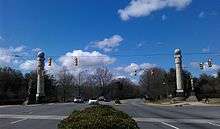
Each holds a disc that symbolizes the four drivers of the city's economy - Gears of Industry, Flames of Knowledge, Stars of Inspiration, and Bolts of Energy. The ribbons in the Civitates' clothing and hair transform into wings, inferring the textile industry as the foundation of the city's growth.[16]
The 22-foot-tall (6.7 m) Civitas statues were made of bronze by the New York sculptor Audrey Flack. Originally they were to be installed in Uptown Charlotte, but were offered to the city of Rock Hill.
In 1992, a fifth Civitas statue by Flack was placed at the City Hall in downtown Rock Hill.
The 60-foot-tall (18 m) columns that form the Gateway came from the old (1914-87) Egyptian Revival Masonic Temple in Charlotte, North Carolina. They were gifted to the city by the First Union Corporation, and are regarded among the area’s most treasured historical artifacts.
Geography and climate
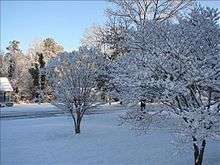
According to the United States Census Bureau, the city has a total area of 43.16 square miles (111.8 km2), of which, 43.0 square miles (111 km2) of it is land and 0.16 square miles (0.41 km2) of it (0.4%) is water.
Rock Hill is located along the Catawba River in the north-central section of the Piedmont of South Carolina near Charlotte. The city sits at an elevation of around 676 feet (206 m) above sea level. It is located approximately 150 miles (240 km) from the Atlantic Ocean and 75 miles (121 km) from the Blue Ridge Mountains.
Rock Hill has a humid subtropical climate, characterized by humid summers and cool dry winters. Precipitation does not vary greatly between seasons. July is the hottest month, with an average high temperature of 91 °F (33 °C) and an average low temperature of 71 °F (22 °C).[17] The coldest month of the year is January, when the average high temperature is 51 °F (11 °C) and the average low temperature is 31 °F (−1 °C).[17] The warmest temperature ever recorded in the city was 106 °F (41 °C) in 1983 and tied in 2007.[17] The coldest temperature ever recorded in the city was −4 °F (−20 °C) in 1985.[17]
| Climate data for Rock Hill, South Carolina | |||||||||||||
|---|---|---|---|---|---|---|---|---|---|---|---|---|---|
| Month | Jan | Feb | Mar | Apr | May | Jun | Jul | Aug | Sep | Oct | Nov | Dec | Year |
| Average high °F (°C) | 51 (11) |
57 (14) |
66 (19) |
75 (24) |
81 (27) |
88 (31) |
91 (33) |
90 (32) |
83 (28) |
74 (23) |
65 (18) |
54 (12) |
73 (23) |
| Average low °F (°C) | 31 (−1) |
36 (2) |
42 (6) |
50 (10) |
59 (15) |
67 (19) |
71 (22) |
70 (21) |
63 (17) |
52 (11) |
43 (6) |
34 (1) |
52 (11) |
| Average precipitation inches (mm) | 3.73 (94.7) |
3.77 (95.8) |
4.17 (105.9) |
3.12 (79.2) |
2.83 (71.9) |
4.05 (102.9) |
3.87 (98.3) |
3.96 (100.6) |
3.49 (88.6) |
3.36 (85.3) |
3.39 (86.1) |
3.43 (87.1) |
43.17 (1,096.4) |
| Average snowfall inches (cm) | 2.0 (5.1) |
1.5 (3.8) |
0.9 (2.3) |
0 (0) |
0 (0) |
0 (0) |
0 (0) |
0 (0) |
0 (0) |
0 (0) |
0.1 (0.3) |
0.9 (2.3) |
5.4 (13.7) |
| Average precipitation days | 11.2 | 9.3 | 10.8 | 8.6 | 10.1 | 10.3 | 11.0 | 9.6 | 7.9 | 6.5 | 8.6 | 10.0 | 113.9 |
| Average snowy days (≥ 2.5) | 1.0 | 0.6 | 0.3 | 0 | 0 | 0 | 0 | 0 | 0 | 0 | 0.1 | 0.5 | 2.5 |
| Mean monthly sunshine hours | 173.6 | 180.8 | 235.5 | 270.0 | 291.4 | 288.0 | 291.5 | 272.8 | 240.0 | 229.4 | 177.0 | 167.4 | 2,817.4 |
| Source: Temperatures & precipitation,[17] snowfall, sunshine | |||||||||||||
Demographics
| Historical population | |||
|---|---|---|---|
| Census | Pop. | %± | |
| 1880 | 809 | — | |
| 1890 | 2,744 | 239.2% | |
| 1900 | 5,485 | 99.9% | |
| 1910 | 7,216 | 31.6% | |
| 1920 | 8,809 | 22.1% | |
| 1930 | 11,322 | 28.5% | |
| 1940 | 15,009 | 32.6% | |
| 1950 | 24,502 | 63.2% | |
| 1960 | 29,404 | 20.0% | |
| 1970 | 33,846 | 15.1% | |
| 1980 | 35,327 | 4.4% | |
| 1990 | 41,643 | 17.9% | |
| 2000 | 49,765 | 19.5% | |
| 2010 | 66,154 | 32.9% | |
| Est. 2016 | 72,937 | [18] | 10.3% |
As of the 2010 census,[5] there were 66,154 people and 16,059 families residing in the city. The population density was 619.2 people per square kilometre (2,983.5/sq mi). There were 29,159 housing units at an average density of 252.4 per square kilometre (653.8/sq mi). The racial makeup of the city was 54.6% White, 38.3% Black, 1.7% Asian, 0.5% Native American, 0.1% Pacific Islander, 2.7% from other races, and 2.1% from two or more races. Hispanic or Latino of any race were 5.7% of the population.
There were 25,966 households out of which 29.9% had children under the age of 18 living with them, 38.1% were married couples living together, 18.8% had a female householder with no husband present, and 38.2% were non-families. 30.3% of all households were made up of individuals and 8.6% had someone living alone who was 65 years of age or older. The average household size was 2.43 and the average family size was 3.04.
In the city, the population was spread out with 24.4% under the age of 18, 14.7% from 18 to 24, 28.5% from 25 to 44, 22.0% from 45 to 64, and 10.4% who were 65 years of age or older. The median age was 31.9 years. For every 100 females there were 85.3 males. For every 100 females age 18 and over, there were 80.3 males.
Neighborhoods
Rock Hill consists of numerous neighborhoods, some of which were independent towns and communities at one time that were later annexed into Rock Hill city limits.
Economy
| 3D Systems |
| Amida Industries, INC. |
| Carolina Energy |
| City of Rock Hill |
| Comporium Communications |
| Cytec Carbon Filters, LLC. |
| Hyosung Corporation |
| Langer Transport Corporation |
| Rock Hill Schools |
| Winthrop University |
Rock Hill's economy was once dominated by the textile industry, and the restructuring of that industry in moving jobs overseas caused a decline in the local economy at one time. Over the past decade, Rock Hill has transitioned to a relatively strong manufacturing workforce.
The median income for a household in the city was $37,336, and the median income for a family was $45,697. Males had a median income of $32,156 versus $24,181 for females. The per capita income for the city was $18,929. About 9.7% of families and 14.0% of the population were below the poverty line, including 16.2% of those under age 18 and 12.0% of those age 65 or over. The unemployment rate of the city was 8.7 percent and 11,874 of the 71,459 residents lived and worked in the city with a daytime population change of +5,208 as of March 2011.[21] The city is transitioning to a retail and manufacturing economy, and has been working to attract national and global companies.
Shopping
- Rock Hill Galleria is a regional shopping mall anchored by Belk's, Sears, JC Penney, Walmart (one of two in the city), along with around 50 specialty stores and a food court.
- Manchester Village is another shopping center. The complex is anchored by nine national retailers, a Regal 14-screen movie theater, and many other specialty shops.
- Riverwalk is a mixed-use community consisting of specialty stores and restaurants located along the Catawba River on the eastern city boundary.
Natural disasters

Three major natural disasters have struck the city.
1926 Rock Hill tornado
On November 26, 1926 a destructive tornado struck downtown Rock Hill. It was the day after Thanksgiving, late in the season for such a violent storm. The "black as ink twister" took less than 10 minutes to change the face of the business section. The storm touched down in western York County, and entered Rock Hill from the west. Once in the town, the twister cut a path about three blocks wide, leaving 60 homes heavily damaged, the hospital roof removed, and cars flipped or crushed. By the end, the total damage for the whole town was $150,000. The tornado was responsible for one death and 12 injuries within Rock Hill.
Hurricane Hugo
Hurricane Hugo struck the city on the morning of September 22, 1989. The storm ripped through the city with sustained winds over 90 MPH, toppling massive oak and pine trees. Schools were closed for weeks because of widespread damage to roads and facilities. The total damage cost for the entire state of South Carolina was around $4.2 billion. The storm was a category 3 when it entered the county and was a category 2 as it left the county.
2004 blizzard
A complex series of low pressure systems moved across South Carolina from February 25–27 of 2004. Starting as a mix of snow and sleet, the storm became all snow as the low pulled off the Carolina coast. Cold arctic air settled over the Carolinas and dumped 22 inches of snow, with lightning, gusty winds, and some areas getting up to 28 inches.[22] Sustained winds over 40 MPH across Rock Hill knocked out power, resulting in schools' closing for a week. It was the worst overall blizzard to hit the area.
Education
.jpg)
K-12
Rock Hill is served by York County School District 3, which has twenty-seven schools in the city, including seventeen elementary schools, five middle schools, and three high schools. The district has a student enrollment of around 25,000.[23][24]
High Schools
- Rock Hill High School (first built high school in the city)
- Northwestern
- South Pointe, the newest high school in the city.
Middle Schools
- Saluda Trail Middle School
- Castle Heights Middle School
- Sullivan Middle School
- Rawlinson Road Middle School
- Dutchman Creek Middle School
Private Schools
A variety of religious schools also serve the city of Rock Hill, including St. Anne's Catholic School and Westminster Catawba. The city is also home to York County's only Charter school, York Preparatory Academy.
Higher Education
There are three colleges in Rock Hill.
The most prominent institution is Winthrop University, founded in 1886 as a women's college. It is a thriving, public, co-ed four-year liberal arts college with an annual enrollment of over 7,000 students.
Clinton Junior College is a historically black, two-year institution founded by the African Methodist Episcopal Zion Church in 1894. It is now a community college for the city of Rock Hill and York County.[25]
York Technical College opened in Rock Hill in 1964. This two-year community college offers associate degrees and provides continuing education for approximately 9,000 area residents annually and is growing each year.[26]
Media
Rock Hill is home to a daily newspaper, The Herald, which covers the area. Magazines include Rock Hill Magazine and YC (York County) Magazine (which covers the entire county).
OTS Media Group owns and operates WRHI (News/Sports, 1340 AM and 94.3 FM), WRHM-FM Country/Sports and WRHM-FM HD2/W281BE (Contemporary Christian, 104.1 FM). There are also WAVO (Standards, 1150 AM), NPR affiliate WNSC-FM (88.9 FM), and the Southside Baptist Church of Rock Hill Christian broadcast station, WRHJ-LP 93.1.
Rock Hill has several television stations: PBS affiliate WNSC-TV (Channel 30), CN2, a daily cable news program produced by Comporium Communications for York, Chester, and Lancaster counties; Fox-owned MyNetworkTV station WMYT-TV Channel 55, is licensed to Rock Hill, but serves the entire Charlotte market, while their studios are shared with sister station WJZY-TV in unincorporated Mecklenburg County, NC.
Transportation
Highway
From locations across the country, Rock Hill is most easily accessible by interstate highway.
- Interstate 77: Exit numbers 73-82
- Interstate 85: Exit number 102
Air
Rock Hill has two local airports. The Rock Hill/York County Airport is a municipal airport for the city of Rock Hill and serves non-commercial flights. The airport is located minutes from Rock Hill's Central business district. Also called Bryant Field, it was named for Robert E. Bryant, an aviator with two international records and an inductee in the South Carolina Aviation Hall of Fame (The name is no longer used for the airport because of confusion with Bryant Field (airport)). It is owned and operated by the City of Rock Hill, but York County is also represented on the Airport Commission.
The other local airport, the Charlotte-Douglas International Airport, is one of the busiest airports in the United States and is located 20 miles from Rock Hill in Charlotte, North Carolina.
Public Transportation
Rock Hill has one regional transit system, The Charlotte Area Transit System that offers express bus service from downtown Rock Hill to Uptown Charlotte.
- 82X Downtown Rock Hill to Manchester Village to Uptown Charlotte.
Bike
Rock Hill is considered to be a bicycle-friendly town with numerous bike routes located throughout the city. There are also designated bike lanes located along major roads such as Eden Terrace and Oakland Avenue. [27]
Public services
- Rock Hill Fire Department is a paid department made of two divisions and six fire stations located within the city.
- Rock Hill Police Department is the city's police force, comprising five divisions and nine specialized units.
- Piedmont Medical Center is an acute care hospital with a Level III trauma center, located in Rock Hill.
Arts and culture
Seasonal events
Rock Hill hosts several seasonal events. Each spring there is a festival called Come See Me Festival which brings more than 125,000 people to the city each year from across the country. Come-See-Me was voted as the number one South Carolina Festival and has been featured in Southern Living magazine. On Independence Day, Rock Hill hosts its annual Red, White, and Boom Festival. Over the first weekend of each October, the Arts Council of York County hosts the Blues & Jazz Festival, which includes a restaurant crawl through Old Town Rock Hill, and a day of blues & jazz events for children. In November, the Arts Council hosts the Underexposed Film Festival YC, bringing independently-created short films from across the world to Rock Hill. A winter festival is held annually in the first week of December and is called ChristmasVille Rock Hill; it has been voted one of South Carolina's most visited attractions.
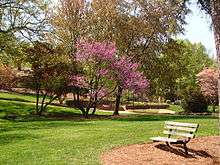
Museums

Seven museums are located in the city, and many more in the area.
- The York County Museum of Rock Hill is a cultural and natural history museum located near the Rock Hill Airport.
- The Comporium Telephone Museum is a historical museum located in Downtown about the history of technology in Rock Hill.
- The Rock Hill Fire Museum is a museum located in Downtown about the history of the Rock Hill Fire Department.
- The Center for the Arts is an art museum also located in Downtown and owned by the York County Arts Council viewing local art.
- The Tom S Getty Art Center is a local art museum featuring local art located in Downtown Rock Hill
- The Main Street Children's Museum is located in Downtown as well, specializing in children's learning and educational activities.
- The White Home is a museum and park on White Street and is on the National Register of Historical Places.
Museums outside Rock Hill include Historic Brattonsville, the Catawba Cultural Center at the Catawba Indian reservation, and several museums located in the Charlotte area.
Sports
Rock Hill hosts two national championships, the United States Disc Golf Championship at Winthrop University, and the US Youth Soccer National Championships at Manchester Meadows Soccer Complex.
Rock Hill hosted the 2015 IQA World Cup, making it the second consecutive year South Carolina will hosted the Quidditch World Cup.[29]
Rock Hill will host the 2017 UCI BMX World Championships in July at the Riverwalk mixed-use community along the Catawba River.[30]
Collegiate sports include the Winthrop University Eagles, a National Collegiate Athletic Association (NCAA) Division I team.[31]
Former sports teams include the Rock Hill Cardinals, a Western Carolinas League baseball team affiliated with the St. Louis Cardinals that existed from 1963–1968.[32]
Parks and recreation
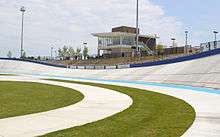
There are numerous hiking, kayaking and bicycling options both in and near the city of Rock Hill.
The city itself is home to thirty-one parks, four recreational centers, one botanical garden, along with the many hiking and biking trails.
There are also numerous parks located minutes from the city's downtown.
- Nanny Mountain County Park, small mountain with short hiking trail and summit views.
- Ebenezer County Park, beachfront park located along Lake Wylie with swimming and picnic options.
- Kings Mountain State Park, state-operated park with numerous hiking and horseback riding trails.
- Kings Mountain National Military Park, historic park most famously known for the Battle of Kings Mountain.
- Andrew Jackson State Park, state-operated park surrounded by disidous trees and a small lake.
- Landsford Canal State Park, state-operated park along the Catawba River famously known for the spider-lilies bloom of late May.
- Crowders Mountain State Park, highly visited mountain with summit views of Charlotte and adjacent York County.
Government
The city operates under a Council-Manager form of government. The governing body is composed of a mayor and six members. The mayor is determined through a nonpartisan, at-large election for a four-year term of office while council members are chosen through nonpartisan, single-member district elections. Council members are elected to staggered four-year terms of office.
The city council is a legislative body, establishing policies with recommendations from the city administrator. The city manager acts as the chief administrator of the council's policies implemented through the administrative control of city departments given to him by ordinance.
- Mayor
- Doug Echols (term expires 2018)
Notable people
- Matt Christopher, children's sports author (d. 1997)[33]
- DJ Felli Fel., charted on the Hot 100 with "Get Buck in Here" 2007
- Sparky Anderson, baseball manager[34]
- Jim Hoagland, journalist and a two-time Pulitzer Prize winner
- Ironing Board Sam, blues keyboardist[35]
- William Ivey Long, Tony Award-winning costume designer
- Vernon Grant, commercial artist and creator of the Snap, Crackle and Pop characters for Kellogg's Rice Krispies cereal
- Edmund Lewandowski, Precisionist movement artist, chairman of the art department at Winthrop, from 1973 to 1984[36]
- David Ball, Country music singer
- William G. Enloe, mayor of Raleigh, North Carolina[37]
- Leon Rippy, actor in The Patriot
- Lauren Cholewinski, Olympic speedskater
- Lafayette Currence, baseball player
- Jim Ray, Major League Baseball pitcher
- Justin Worley, QB for Tennessee
- Mason Rudolph, QB for Oklahoma State
- Buddy James Porter, Professional Wrestler, d. January 5, 2005
National Football League players
In popular culture
Films
- The Patriot (2000 film), rural Rock Hill, starring Mel Gibson, Heath Ledger
- Black Rainbow
- The Rage: Carrie 2
- Asylum (2008 film), at Winthrop University
- Walker Payne 2006
- Gospel Hill 2008
- One Church
Awards
Rock Hill is a four-time winner of America's Promise Alliance "100 Best Communities for Young People",[38] and a previous winner of the National Civic League's All-America City Award.[39]
References
- ↑ "2010 Census Redistricting Data (Public Law 94-171) Summary File". American FactFinder. United States Census Bureau. Archived from the original on 22 July 2017. Retrieved 22 July 2017.
- ↑ "American FactFinder". United States Census Bureau. Archived from the original on 2013-09-11. Retrieved 2008-01-31.
- ↑ "US Board on Geographic Names". United States Geological Survey. 2007-10-25. Retrieved 2008-01-31.
- ↑ "Multimedia". USA Today.
- 1 2 "American FactFinder". United States Census Bureau. Archived from the original on 2013-09-11. Retrieved 2017-07-22.
- 1 2 3 4 5 6 7 8 9 10 11 12 13 14 15 16 17 18 19 20 Willoughby, Lynn (2002). The "Good Town" Does Well: Rock Hill, S.C., 1852-2002. Orangeburg, South Carolina: Written in Stone. ISBN 0-9669707-2-1.
- 1 2 "’Sing-In’ Negroes Eat Hearty; Say ‘Jail—No Bail’". The Spartanburg Herald. Associated Press. February 21, 1961. Retrieved December 1, 2010.
Eight Negro Demonstrators in a disciplinary cell at the York County Prison Camp accepted and ate second helpings Monday of the full meal given every third day to prisoners on bread and water.
- ↑ "The Friendship Nine / January 31, 1961". Herald Online. February 22, 2004. Retrieved December 1, 2010.
They were students at Friendship College and called themselves the Friendship Nine. The members of this group were James Wells, William "Dub" Massey, Robert McCullough, John Gaines, William "Scoop" Williamson, Willie McLeod, Thomas Gaither, Clarence Graham, Charles Taylor and Mack Workman.
- ↑ "'Thank you, my brother'". heraldonline. Retrieved 2016-01-18.
- ↑ "York County files lawsuit against Rock Hill proposed landfill".
- ↑ "York County sludge complaints".
- ↑ "Chester complains about sludge".
- ↑ "Charlotte also dumping sludge in Chester Co.".
- ↑ "Waste to energy future plans" (PDF).
- ↑ "Civitas Statues - Rock Hill, SC - Figurative Public Sculpture on Waymarking.com". www.waymarking.com. Retrieved 2017-01-27.
- ↑ "Rock Hill, SC : About Rock Hill". www.cityofrockhill.com. Retrieved 2017-01-27.
- 1 2 3 4 5 "Monthly Averages for Rock Hill, SC". The Weather Channel. Retrieved November 21, 2011.
- ↑ "Population and Housing Unit Estimates". Retrieved June 9, 2017.
- ↑ "Census of Population and Housing". Census.gov. Archived from the original on May 12, 2015. Retrieved June 4, 2015.
- ↑ Rock Hill, SC Top Companies | Live Data. Bestplacelive.com. Retrieved on 2012-10-15.
- ↑ "Area sees little change in jobs" Archived 2010-08-24 at the Wayback Machine., Herald Online
- ↑ "Winter Weather Event, February 25–27, 2004". South Carolina State Climatology Office. Retrieved 10 January 2012.
- ↑ "Rock Hill District Three". Retrieved 2009-07-21.
- ↑ "Rock Hill District Three Information". Retrieved 2009-07-21.
- ↑ "Clinton Junior College". Archived from the original on 2012-07-01. Retrieved 2009-07-21.
- ↑ "York Technical College". Retrieved 2009-07-21.
- ↑ "Bike Rock Hill". June 2017.
- ↑ "World's Hottest Pepper is Grown in South Carolina". CBS News. December 26, 2013.
- ↑ "World Cup 8 Rock Hill USA April 2015". July 2017.
- ↑ "2017 BMX World Championships". June 2017.
- ↑ "Winthrop Eagles". July 2017.
- ↑ "Rock Hill Cardinals". July 2017.
- ↑ Dale Christopher, Behind the Desk With Matt Christopher: The #1 Sportswriter for Kids, New York: Little, Brown and Company, 2004
- ↑ "Sparky Anderson Minor League Statistics & History - Baseball-Reference.com". Baseball-Reference.com. Retrieved 8 July 2015.
- ↑ "Ironing Board Sam". Bluessearchengine. Retrieved 2012-10-16.
- ↑ Valerie Ann Leeds, "Edmund Lewandowski's Mosaic Murals," American Art Review, 18(March–April 2006), pp. 142-47.
- ↑ "Enloe, William Gilmore (1902) › Page 2 - Fold3.com". fold3.com. Retrieved 8 July 2015.
- ↑ "100 Best Communities for Young People". Americas Promise Alliance. Retrieved 10 February 2012.
- ↑ "Previous Winners". National Civic League. Retrieved 24 January 2017.
External links
- Official website
-
 Rock Hill travel guide from Wikivoyage
Rock Hill travel guide from Wikivoyage
